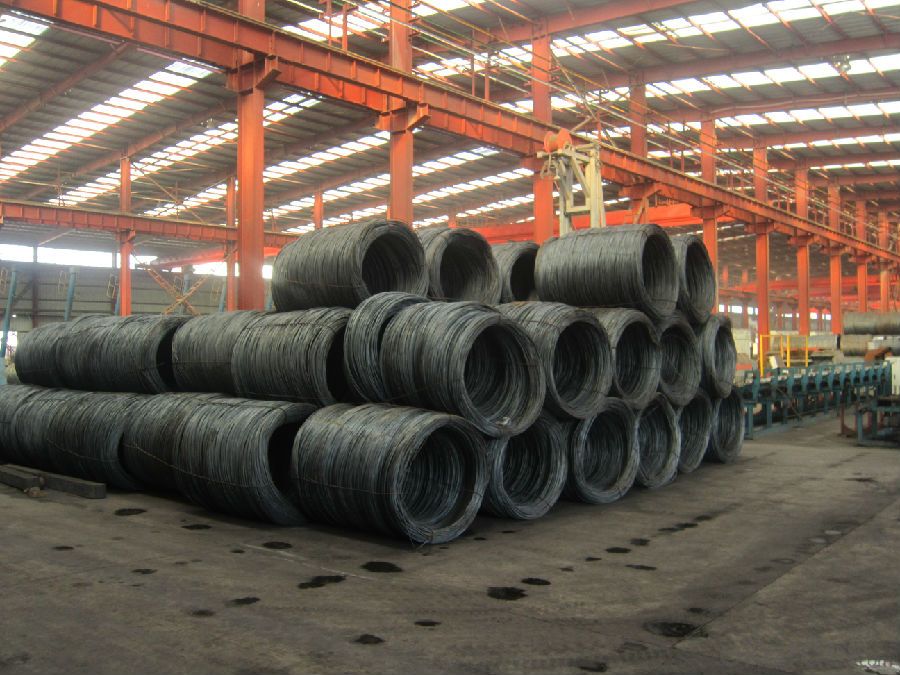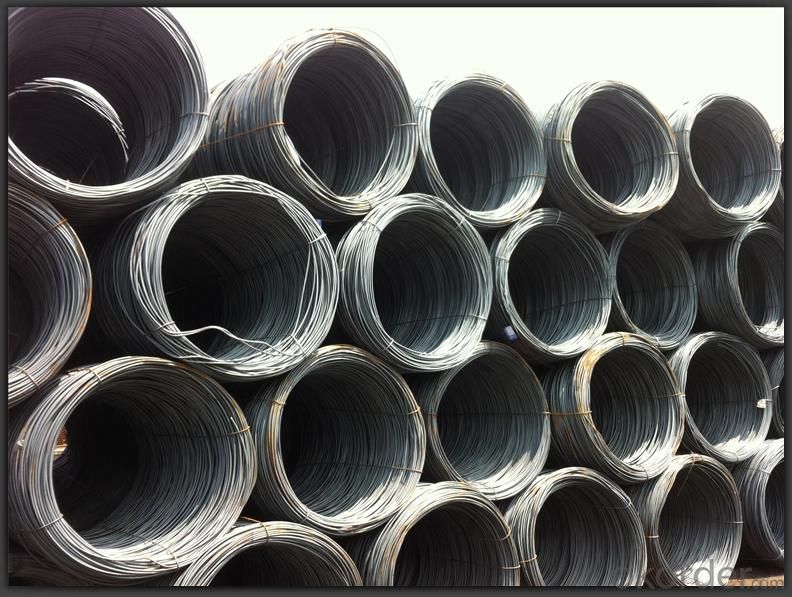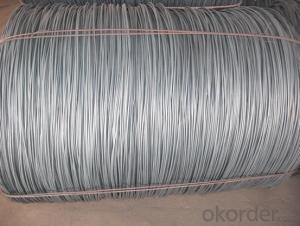Wire Rod Hot Rolled High Quality 5.5MM-14MM
- Loading Port:
- Tianjin
- Payment Terms:
- TT OR LC
- Min Order Qty:
- 25 m.t.
- Supply Capability:
- 2000000 m.t./month
OKorder Service Pledge
OKorder Financial Service
You Might Also Like
Item specifice
Product Description:
OKorder is offering high quality Hot Rolled Steel I-Beams at great prices with worldwide shipping. Our supplier is a world-class manufacturer of steel, with our products utilized the world over. OKorder annually supplies products to European, North American and Asian markets. We provide quotations within 24 hours of receiving an inquiry and guarantee competitive prices.
Product Applications:
After hot-rolled the products shaped into coil and delivery as finished product, including round, square, rectangular, hexagonal and so on. Since most of the products are round, it is generally called wire rod. Carbon steel wire rod is widely used in construction and manufacturing. Carbon steel wire rod is mainly used for reinforcement of reinforced concrete and welded structure or reprocessed (roberts , nail, etc.) materials, especially used to produce wire drawing, welding electrode, nails, spring, electronic, precise machinery parts and so on.
Product Advantages:
OKorder's Steel I-Beams are durable, strong, and resist corrosion.
Main Product Features:
· Premium quality
· Prompt delivery & seaworthy packing (30 days after receiving deposit)
· Corrosion resistance
· Can be recycled and reused
· Mill test certification
· Professional Service
· Competitive pricing
Product Specifications:
Manufacture: Hot rolled
Grade: SAE1008 SAE 1006
Certificates: ISO, SGS, BV, CIQ
Diameter: 5.5mm, 6.5mm, 7mm,8mm,9mm,10mm,12mm,14mm, as per customer request
Packaging: Export packing, nude packing, bundled
Grade | Chemical Composition (%) | |||||
C | Mn | S | P | Si | B | |
SAE1008B | 0.10max | 0.32max | 0.045max | 0.040max | 0.30max | 0.0008min |
Mechanical properties | ||||||
Yield strength(N/mm2) | Tensile strength(N/mm2) | Elongation (%) | ||||
≥195 | 350-380 | ≥32 | ||||
FAQ:
Q1: How soon can we receive the product after purchase?
A1: Within three days of placing an order, we will begin production. The specific shipping date is dependent upon international and government factors, but is typically 7 to 10 workdays.
Q2: What makes stainless steel stainless?
A2: Stainless steel must contain at least 10.5 % chromium. It is this element that reacts with the oxygen in the air to form a complex chrome-oxide surface layer that is invisible but strong enough to prevent further oxygen from "staining" (rusting) the surface. Higher levels of chromium and the addition of other alloying elements such as nickel and molybdenum enhance this surface layer and improve the corrosion resistance of the stainless material.
Q3: Can stainless steel rust?
A3: Stainless does not "rust" as you think of regular steel rusting with a red oxide on the surface that flakes off. If you see red rust it is probably due to some iron particles that have contaminated the surface of the stainless steel and it is these iron particles that are rusting. Look at the source of the rusting and see if you can remove it from the surface.


- Q:How are steel wire rods used in the manufacturing of bicycle spokes for strength and durability?
- Steel wire rods are used in the manufacturing of bicycle spokes because they provide strength and durability to support the weight and stress exerted on the spokes while riding. The high tensile strength of steel wire rods allows the spokes to withstand heavy loads and resist deformation, ensuring a reliable and long-lasting performance for the bicycle.
- Q:How is steel wire rod used in the manufacturing of wire forms for medical devices?
- Steel wire rod is an essential component in the manufacturing of wire forms for medical devices. It serves as the raw material that is processed and transformed into various wire forms used in medical applications. Firstly, the steel wire rod undergoes a series of processes such as drawing, annealing, and coating to improve its properties and make it suitable for medical device applications. Drawing involves reducing the diameter of the wire rod through a series of dies, resulting in a thinner and more flexible wire. Annealing is a heat treatment process that enhances the wire's ductility and removes any residual stresses. Coating, such as electroplating or passivation, is applied to the wire to provide corrosion resistance and improve biocompatibility. Once the steel wire rod is processed, it can be used to manufacture a wide range of wire forms for medical devices. These wire forms include springs, coils, guidewires, catheters, and various surgical instruments. Springs made from steel wire rod are used in devices such as implantable cardiac pacemakers, where they provide mechanical support and help regulate the heart's rhythm. Coils and guidewires made from steel wire rod are used in minimally invasive procedures, such as stenting or catheterization, where they provide flexibility and maneuverability to navigate through blood vessels or other body structures. The high strength and durability of steel wire rod make it suitable for applications where reliability and precision are critical, such as orthopedic implants or surgical instruments. It can be formed into intricate shapes and sizes, allowing for the production of customized wire forms that meet the specific requirements of different medical devices. Additionally, steel wire rod's biocompatibility, when properly coated or treated, ensures that it does not react adversely with the human body, making it safe for use in medical applications. In summary, steel wire rod plays a crucial role in the manufacturing of wire forms for medical devices. Through various processing techniques, it is transformed into springs, coils, guidewires, and other wire forms that provide mechanical support, flexibility, and precision in medical applications. Its strength, durability, and biocompatibility make steel wire rod an ideal choice for the production of wire forms used in medical devices.
- Q:What are the common manufacturing defects in steel wire rod?
- Common manufacturing defects in steel wire rod include surface defects such as scratches, pits, and grooves, as well as internal defects like cracks, inclusions, and segregation. Other defects may include improper dimensions, excessive or insufficient coil weight, and improper surface finish.
- Q:How is the grain size of steel wire rod measured?
- Metallography, a method commonly employed for measuring the grain size of steel wire rod, involves a series of steps. Initially, a small piece of the rod is cut, and subsequently, it is subjected to grinding and polishing to procure a smooth surface. Once the surface is adequately prepared, a chemical reagent is employed to etch the sample, thereby unveiling the grain boundaries. This etching process facilitates the differentiation of individual grains and enhances their visibility when observed through a microscope. Following the etching process, the sample is meticulously examined under a high magnification microscope. During this examination, the grains are meticulously counted, and their size is determined using either a measuring reticle or specialized software. Consequently, the grain size is typically reported as either an average grain diameter or a grain size number, representing the number of grains within a given area. It is crucial to acknowledge that the measurement of grain size is subject to subjectivity and may vary according to the observer's interpretation. Therefore, standardized methodologies such as ASTM E112 or ISO 643 are commonly employed to ensure uniformity and precision in grain size measurements. These standards offer comprehensive guidelines regarding sample preparation, etching techniques, and grain size determination.
- Q:What are the common applications of half-hard steel wire rod?
- Half-hard steel wire rod is commonly used in various applications due to its specific properties and characteristics. Some of the common applications of half-hard steel wire rod include: 1. Wire forming: Half-hard steel wire rod is widely used in wire forming processes, such as bending, twisting, and shaping into different forms and sizes. It can be used to create wire-based products like springs, clips, hooks, and fasteners. 2. Construction industry: Half-hard steel wire rod is used in the construction industry for reinforcing concrete structures. It is often used as reinforcement in concrete slabs, walls, beams, and columns, providing tensile strength and stability to the structure. 3. Automotive industry: Half-hard steel wire rod is utilized in the automotive industry for various purposes. It is commonly used in manufacturing automotive springs, including suspension springs, seat springs, and valve springs. The high strength and resilience of half-hard steel wire rod make it ideal for these applications. 4. Manufacturing of wire products: Half-hard steel wire rod is used in the manufacturing of a wide range of wire products. It is commonly used in the production of wire mesh, wire ropes, cables, fencing, and wire-based filters. The half-hardness of the steel wire rod allows for the desired flexibility and strength required for these applications. 5. Electrical and electronic industry: Half-hard steel wire rod is used in the electrical and electronic industry for various purposes. It is commonly used in the production of electrical and communication cables, providing strength and durability to the cables. It is also used in the manufacturing of electronic components and connectors. 6. Jewelry making: Half-hard steel wire rod is sometimes used in jewelry making, especially for creating wire-based jewelry designs. It can be shaped into various forms, such as rings, bracelets, and pendants, and its half-hardness allows for the desired level of flexibility and durability. Overall, half-hard steel wire rod finds its applications in various industries and sectors due to its strength, malleability, and usability in wire-based products and structures.
- Q:How is steel wire rod used in the production of tire cords?
- Steel wire rod is an essential component in the production of tire cords. Tire cords are reinforcements that are embedded within the rubber of tires to provide strength and support. Steel wire rod is first processed through a series of steps to transform it into the desired form for tire cord production. The steel wire rod is initially hot rolled to reduce its diameter and increase its length. This process adds strength and flexibility to the wire rod, making it suitable for tire cord applications. After hot rolling, the wire rod is further processed through a heat treatment known as patenting. This heat treatment enhances the wire's mechanical properties, such as tensile strength and elasticity, ensuring it can withstand the demanding conditions experienced by tires. Once the steel wire rod has been appropriately processed, it is then drawn through a series of dies to achieve the desired diameter and surface finish. This drawing process further enhances the wire's strength and surface quality, ensuring it meets the stringent requirements for tire cord production. The drawn steel wire rod is then coated with a layer of brass or zinc to improve its adhesion to the rubber compound used in tire manufacturing. This coating also provides corrosion resistance, extending the lifespan of the tire cords. Finally, the coated steel wire rod is twisted into cord structures with multiple strands, forming the tire cord. These cords are then embedded into the rubber during the tire manufacturing process. The tire cords provide essential reinforcement, helping the tire withstand the internal pressure, external forces, and provide stability during vehicle movement. In summary, steel wire rod is a crucial material used in the production of tire cords. Through a series of processing steps, including hot rolling, heat treatment, drawing, and coating, the wire rod is transformed into high-strength and durable cords. These cords are then embedded within the rubber of tires to provide essential reinforcement and support, ensuring the tires can withstand the challenging conditions they encounter on the road.
- Q:How does the elongation of steel wire rod vary with different wire drawing processes?
- The elongation of a steel wire rod can vary depending on the specific wire drawing process employed. Different processes, such as cold drawing or hot drawing, can impact the elongation of the wire differently. Cold drawing typically results in higher elongation as the wire is pulled through a series of dies at room temperature, causing the metal to stretch and elongate. On the other hand, hot drawing involves heating the wire rod before drawing it through the dies, which can result in lower elongation due to the higher temperature softening the metal. Additionally, the speed and force applied during the drawing process can also affect the elongation of the steel wire rod.
- Q:How is steel wire rod used in the production of wire for mattress springs?
- Steel wire rod is used in the production of wire for mattress springs as it serves as the primary material for manufacturing the springs. The wire rod undergoes a series of processes such as drawing, annealing, and coiling to transform it into a fine, strong, and resilient wire that is then used to create the springs found within mattresses.
- Q:What are the transportation options for steel wire rod?
- The transportation options for steel wire rod can include trucking, railway transportation, and shipping by sea or air.
- Q:How is steel wire rod used in the manufacturing of wire brushes?
- Steel wire rod is used in the manufacturing of wire brushes as it serves as the raw material for the bristles or filaments of the brush. The wire rod is transformed into fine wires, which are then twisted, knotted, or crimped to form the brush bristles. These bristles are attached to a handle or base to create wire brushes that are widely used for cleaning, polishing, and surface preparation in various industries and household applications.
1. Manufacturer Overview |
|
|---|---|
| Location | |
| Year Established | |
| Annual Output Value | |
| Main Markets | |
| Company Certifications | |
2. Manufacturer Certificates |
|
|---|---|
| a) Certification Name | |
| Range | |
| Reference | |
| Validity Period | |
3. Manufacturer Capability |
|
|---|---|
| a)Trade Capacity | |
| Nearest Port | |
| Export Percentage | |
| No.of Employees in Trade Department | |
| Language Spoken: | |
| b)Factory Information | |
| Factory Size: | |
| No. of Production Lines | |
| Contract Manufacturing | |
| Product Price Range | |
Send your message to us
Wire Rod Hot Rolled High Quality 5.5MM-14MM
- Loading Port:
- Tianjin
- Payment Terms:
- TT OR LC
- Min Order Qty:
- 25 m.t.
- Supply Capability:
- 2000000 m.t./month
OKorder Service Pledge
OKorder Financial Service
Similar products
New products
Hot products
Related keywords




























